When a journal adds a new associate editor, that change means more for readers than just a tweak to the masthead. New associate editors bring new experiences, new perspectives, and new ideas to their publications. Get to know some of ACS’s latest editors and learn what unique gifts they’ll be bringing to their respective journals. […]

Ashutosh Sharma, ACS Applied Materials & Interfaces

What is your research focus? What initially attracted you to your field?
In the last 35 years, my primary focus has been on soft interfaces, colloids, and nanoscale entities and their myriad applications and tech development. These applications have at different times branched into self-organization in nanoscale films; nanofabrication and micro/nano-patterning; wetting, adhesion, and friction; electrospinning of functional materials for devices; carbon and polymeric nanocomposites for environmental remediation, energy storage, and health (theranostics, biosensors) and biomaterials.
When I started on my Ph.D. work back in 1984, the 2-D world of interfaces, such as its thermodynamics and mechanics, was an upcoming, exciting area in chemical engineering with many interesting potential applications. During this time, I initiated work on the pathophysiology of Dry Eye Syndromes in the framework of thin films (tear film) and wetting (cornea), which was a first. Basically, my interest all along has been in connecting different dots of knowledge that seemingly appear to be disjointed. This approach led to many opportunities along the way.
What do you hope to bring to your journal?
What are the major challenges facing your field today?
An overarching challenge is a contextually meaningful, synergistic convergence of elements and functionalities in the new materials/interfaces that are engineered to provide solutions to a problem, which is actually a multidimensional problem, as most of the real ones are. For example, miniaturized low-cost autonomous sensor networks (smart pebbles) that seamlessly embed some computing at the edge, communication, machine learning, fault diagnosis, and auto-calibration, positional information, actuators for local actions, and a long-lasting power source that may harness vibrations, solar and other stuff such as surrounding fluids! There would have to be greater integration of the physical, digital, and biological for the new multifunctional materials. Nature-inspired materials and manufacturing is a major opportunity in which we have currently only barely scratched the surface. The most popular examples have been superwetting, smart adhesives, structural colors, fog harvesting, etc. However, interesting materials and manufacturing in nature are not passive, but embed information and the action elements, and most often perform functions by being connected to a larger system of communication and computing! On a lighter note, one could think of progressing from the advanced materials, functional materials, smart materials, etc to informational materials, intelligent materials, wise materials, and who knows, even conscious materials that will inspire a series of CONMAT conferences! Other challenges with functional interfaces are their durability and large-scale production.
What do you think is the most interesting and/or important unsolved problem in your field?
On the most fundamental level, inter-surface and inter-particle interactions are rather poorly understood and predicted, especially for the real physico-chemically heterogeneous interfaces in the aqueous media, including bio- and polymeric surfaces. Such interactions include for example the long-range van der Waals, electrostatic and electrodynamic, acid-base (hydrogen bonding) structural and entropic, specific, etc. Another complexity is summing of these interactions for poorly defined heterogeneous interfaces. A rational understanding and the design of interfaces for most applications demand developing such insights at multiple scales.
Do you have a recent paper in an ACS journal that you’d like to highlight?
Self-Organized Wrinkling in Thin Polymer Films under Solvent–Nonsolvent Solutions: Patterning Strategy for Microfluidic Applications
ACS Appl. Polym. Mater. 2021, 3, 12, 6198–6206
DOI: 10.1021/acsapm.1c01044
Thin polymer coatings show a novel self-organized wrinkling instability on their surface when put under a mixture of a good solvent and a non-solvent. The solvent swells the film and the mixture diffusing to the polymer-substrate interface delaminates the film. Interestingly, along a polygonal network of lines where local detachments occur, thus forming buried micro-channels. The selective delamination-induced wrinkling is found to be a rather generic phenomenon that can be tuned in different polymer films of variable thickness by appropriate combinations of solvent–nonsolvent mixtures. The paper has some of the elements I like: discovering a new phenomenon, understanding its control to produce channels of the desired geometry, and potential applications, e.g., in micropatterning and microfluidics.
Anything else you’d like readers to know about you?
My other areas of interest are philosophy and art. Most of my sketches are made while listening to lectures and in meetings! Paradoxically, it mostly allows a better understanding of what the speaker is saying, owing to shutting down the unrelated internal dialogue. Apparently, the brain cannot fully focus on two streams of thoughts simultaneously!
For about seven years, until August 2021, I was a Secretary to the Government of India heading its Department of Science and Technology, which allowed greater appreciation of how science, technology, and innovation connect with different segments of society and how policies are an important instrument of meeting the challenges and leveraging the opportunities of the future through science and technology.
***
David Olson, ACS Chemical Neuroscience
What is your research focus? What initially attracted you to your field?
Our lab studies a class of compounds that we call psychoplastogens, or small molecules capable of promoting neural plasticity. Such compounds have enormous potential for treating a wide variety of illnesses including depression, anxiety disorders, addiction, and neurodegenerative diseases.
We use a combination of synthetic chemistry, molecular neurobiology, and behavioral neuropharmacology to 1) understand the fundamental mechanisms underlying the effects of psychoplastogens on the nervous system, and 2) develop next-generation neurotherapeutics. I was initially attracted to the field of central nervous system drug discovery due to the enormous unmet medical need. There are a ton of people who need help, and current treatments are far from adequate.
What do you hope to bring to your journal?
I hope to continue to raise the profile of ACS Chemical Neuroscience as a premier journal for neuropharmacology research and central nervous system drug discovery.
What are the major challenges facing your field today?
The identification of robust biomarkers that predict treatment efficacy is an issue that continues to plague the development of central nervous system therapeutics. Fortunately, progress in this area is being made.
What do you think is the most interesting and/or important unsolved problem in your field?
Most people now agree that many brain illnesses are a result of pathological neural circuits rather than chemical imbalances. A key challenge for the field going forward will be to find ways to selectively target disease-relevant circuits with brain penetrant small molecules. That type of precision will likely be necessary to both improve efficacy and reduce side effects.
Do you have a recent paper in an ACS journal that you’d like to highlight?
The Subjective Effects of Psychedelics May Not Be Necessary for Their Enduring Therapeutic Effects
ACS Pharmacol. Transl. Sci. 2021, 4, 2, 563–567
DOI: 10.1021/acsptsci.0c00192
Anything else you’d like readers to know about you?
In addition to developing new neurotherapeutics, I’m also very passionate about understanding how psychedelics produce their effects on brain structure and function. Psychedelics are some of the most powerful substances known to impact the brain, and I believe that understanding the basic science underlying their effects will lead to important advances in neuroscience.
***
Karmella Haynes, ACS Synthetic Biology

What is your research focus? What initially attracted you to your field?
My focus is the rational design of components of chromatin (proteins and scaffold RNAs that organize DNA in chromosomes) to control epigenetic gene regulation in human and mammalian cells. I studied basic epigenetic research as a Ph.D. student. After I entered synthetic biology as a postdoc (ca. 2006), I became excited about the idea of epigenetic engineering in eukaryotes, and mammalian synthetic biology in general.
What do you hope to bring to your journal?
I hope to apply my knowledge of advances and barriers in the area of mammalian synthetic biology to the process of sharing the latest findings with the public. I also hope that my connections with the growing mammalian synthetic biology community will encourage early career and historically marginalized scientists to consider ACS Synthetic Biology as a platform for elevating the visibility of their work.
What are the major challenges facing your field today?
Translating biological design principles from viral and bacterial systems to mammalian cells is a major overarching challenge for mammalian synthetic biology. Mammalian cells have the remarkable ability to differentiate into a myriad of specialized states while remaining genetically identical. This poses a significant challenge for an orthogonal genetic circuit that is intended to function in a predictable manner.
What do you think is the most interesting and/or important unsolved problem in your field?
Solving the problem of unexpected epigenetic regulation of synthetic gene circuits will certainly help to advance mammalian synthetic biology. Also, a widely adopted, easy-to-use artificial chromosome that is stable in replicating mammalian cells would make cells much easier to engineer.
Do you have a recent paper in an ACS journal that you’d like to highlight?
Design, Construction, and Validation of Histone-Binding Effectors in Vitro and in Cells
Biochemistry 2018, 57, 31, 4707–4716
DOI: 10.1021/acs.biochem.8b00327
***
Daniel Nomura, Chemical Research in Toxicology

What is your research focus? What initially attracted you to your field?
My group is focused on reimagining druggability using chemoproteomic platforms to develop transformative medicines. One of the greatest challenges that we face in discovering new disease therapies is that most proteins are considered “undruggable,” in that most proteins do not possess known binding pockets or “ligandable hotspots” that small molecules can bind to modulate protein function. Our research group addresses this challenge by advancing and applying chemoproteomic platforms to discover and pharmacologically target unique and novel ligandable hotspots for disease therapy.
What do you hope to bring to your journal?
One of the greatest challenges that we face in discovering new disease therapies is that most proteins are considered “undruggable,” in that most proteins do not possess known binding pockets or “ligandable hotspots” that small molecules can bind to modulate protein function. This challenge requires the development of approaches that not only enable ligand discovery against these undruggable targets but also the invention of new therapeutic modalities to therapeutically exploit these targets in a safe manner.
I hope to bring my expertise in chemical biology, drug discovery, and environmental toxicology, particularly as it relates to small-molecule interactions with macromolecules in our bodies.
***
Doris Braun, Crystal Growth & Design
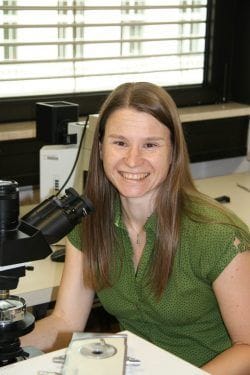
What is your research focus? What initially attracted you to your field?
The “Preformulation and Polymorphism group” at the University of Innsbruck in Austria focuses on scientific and applied problems related to solid-state properties of pharmaceuticals and other small organic molecules of high industrial relevance. We develop methods, strategies, and guidelines for the production and characterization of solid-state forms and drug products.
In particular, my research focuses on:
- The role of computational chemistry for pharmaceutical solid form screening and characterization: how to implement crystal structure prediction into solid form screening and characterization programs.
- Thermodynamic relations in solid forms: how to derive the thermodynamic stability, stability order, and stability ranges of and between different solid-state forms
- Hydrate, solvate, and co-crystal formation: prediction, characterization, and practical consequences.
The beauty of crystals under the microscope attracted me to the field of polymorphism.
What do you hope to bring to your journal?
Materials properties and their applicability have always been the driving force in my research. I have university training in pharmacy, worked on projects focusing on basic research and applied industrial problems. As a scientist, I have taken the role of an experimentalist among world-leading theoretical chemists, and am now applying computational chemistry in an otherwise experimentally focused research group. I hope to play an integral part in maintaining the high standards of the journal, help to encourage (younger) researchers to publish high-quality papers, and promote out-of-the-box thinking of scientists working in the field.
What are the major challenges facing your field today?
Over the last decade, there have been ground-breaking achievements in the field of crystal engineering/materials sciences. Computational chemistry can be used to predict feasible crystal structures. We are aiming at predicting the properties of materials. Experimental techniques have advanced immensely. High-resolution and in-situ data collections allow us to get insights into the structural behavior, transformations, and interrelations of solid forms. Thus, the challenges we have to overcome in our field are not always related to science but are often linked to the accessibility of the (newest) techniques, the time we can spend working on a compound, and the funding opportunities available.
What do you think is the most interesting and/or important unsolved problem in your field?
Despite the ground-breaking advances in the field and the efforts undertaken by scientists in academia and industry worldwide we are still not able to predict if a molecule will crystallize, let alone in what forms or especially under which conditions. The required breakthrough is probably understanding nucleation and growth in practically relevant systems. The ultimate goal is then to design and produce the assembly of new materials with targeted properties.
Do you have a recent paper in an ACS journal that you’d like to highlight?
The Eight Hydrates of Strychnine Sulfate
Cryst. Growth Des. 2020, 20, 9, 6069–6083
DOI: 10.1021/acs.cgd.0c00777
In this study, we aimed at a comprehensive molecular-level understanding of a hydrate forming model compound. The fact that strychnine sulfate shows eight hydrate forms, but no stable and ordered anhydrous phase, highlights the importance of water as a stabilizing agent in solids. Furthermore, the study demonstrates that a series of complementary analytical techniques allowing precise adjustments of humidity and temperature conditions must be employed to reveal the solid-state behavior of complex hydrate systems.
***
Sanjit Konar, Crystal Growth & Design

What is your research focus? What initially attracted you to your field?
The focus of my research team is multidirectional, with special emphasis on the thrust areas, namely responsive molecular crystals (mainly MOFs), molecular magnetism, and nanoscopic polyoxometalates. We aim to design and synthesize magnificent molecular materials whose physicochemical properties could be orchestrated using external stimuli such as light, temperature, pressure, etc, and can be used as molecular switches. In these studies, appropriate selection of the ligand field, along with a proper choice of the redox potential of the molecular components plays a vital role. Moreover, other parameters like the arrangement of the molecules in the crystal lattice, mainly driven by intermolecular interactions, often fine-tune the dynamic and reversibility of the properties. The other aspect of our work includes molecular magnetism. We design single-molecule/ion magnets, magnetic refrigerants, and cages and rationalize their properties experimentally and theoretically to make this field significant progress. In another area, we explore the fascinating electronic, catalytic, and magnetic properties of nanoscopic polyoxometalates(POMs) formed by the early transition metals. The intrinsic color of the transition metal complexes attracts me the most as it provides a clear hint about their structure and reactivity.
What do you hope to bring to your journal?
My background is in transitional metal coordination chemistry, and my current research interest in molecular magnetism, metal-organic frameworks, and polyoxometalates may bring complementary expertise to the editorial board of this journal. I hope to contribute to the area of structure-property relationship in the transition metal-based crystalline compounds.
What are the major challenges facing your field today?
The complexities associated with the structure of a small molecule in the crystal lattice considering the intermolecular interactions and its relationship with the properties might need to reach the next level of understanding for a more efficient design of the materials. Although significant efforts have been devoted in this direction, a faster progression could be achieved by the synergy between the design strategy of the molecules and an adequate understanding of the intermolecular interactions involved therein.
What do you think is the most interesting and/or important unsolved problem in your field?
Even for the simplest molecule, predicting the crystal structure may turn out to be wrong.
Do you have a recent paper in an ACS journal that you’d like to highlight?
Magnetic Transition in Organic Radicals: The Crystal Engineering Aspects
Cryst. Growth Des. 2021, 21, 10, 5473–5489
DOI: 10.1021/acs.cgd.1c00731
Anything else you’d like readers to know about you?
Two things need to be mentioned that help me evolve as a researcher: extensive undergraduate teaching and a scientist at home, my wife, also a chemistry professor.
***
Michael Ruggiero, Crystal Growth & Design

What is your research focus? What initially attracted you to your field?
We are broadly interested in understanding how intermolecular forces shape the properties of condensed phase materials, which we typically achieve through the lens of low-frequency (terahertz) vibrational spectroscopies, supplemented by quantum mechanical simulations. The terahertz vibrational community is one of the most welcoming and collaborative communities I’ve come across, which is the primary reason why I have been in this community from my doctoral studies through my current independent career – basically, great friends, great science, and a whole bunch of fun is what kept me around!
What do you hope to bring to your journal?
I have been impressed with the direction that Crystal Growth & Design has been moving in over the last several years, and I have been quite fortunate to have some of my more ambitious and interesting studies land in the journal. The organic growth of the CGD community, and their keen eye to expanding beyond the traditional crystallography community into related fields, are major driving forces for my desire to be involved. I am very much looking forward to helping to grow the community by acting as a bridge between CGD and the terahertz sciences.
What are the major challenges facing your field today?
The terahertz sciences are rapidly evolving, as instrument costs are decreasing and the technique is easier-than-ever to access. However, with that evolution, there is an influx of new researchers that need to become acquainted with the nuances associated with low-frequency vibrational spectroscopy, which is sufficiently different to comparable methods (e.g., mid-IR vibrational spectroscopies). Thus, there is a need now, more than ever, for detailed studies that clearly highlight experimental methodologies and subsequent analysis techniques.
What do you think is the most interesting and/or important unsolved problem in your field?
One of the most interesting areas of the terahertz sciences, in my opinion, is the increasing finding that solid-state phenomena (reactions, phase transformations, and so on) seem to closely follow a terahertz vibrational normal mode. This has resulted in some interesting and ongoing investigations into driving solid-state reactivity with terahertz radiation, which is one of the ‘holy-grails’ of low-frequency vibrational spectroscopy, in my opinion!
Do you have a recent paper in an ACS journal that you’d like to highlight?
Advances in Low-Frequency Vibrational Spectroscopy and Applications in Crystal Engineering
Cryst. Growth Des. 2022, 22, 2, 939–953
DOI: 10.1021/acs.cgd.1c00850
Anything else you’d like readers to know about you?
I am an avid outdoorsman, and when not playing with lasers you can find me lurking around the Green Mountains of Vermont or the Adirondack Mountains of New York – hiking, camping, skiing, and everything in between – often with my wife and two dogs. I’m also a sucker for a good collaboration, and have a difficult time saying “no” to a fun and interesting problem from a fun and interesting person: basically, we’ll stick anything in our spectrometer, and happily head to the pub for beers after!
***
Shalini Singh, Crystal Growth & Design

What is your research focus? What initially attracted you to your field?
I am a nanomaterial chemist. Currently, my research focus is on synthesizing ultra-thin inorganic nanocrystals composed of a few atomic layers by bottom-up approaches. Creating them atom-by-atom using molecular precursors provides vast opportunities to engineer their structure, dimensions, surface, and properties. By using different spectroscopic and microscopic techniques, we gain a proper understanding of the stoichiometry, crystal structure, morphology, electronic properties, and surface chemistry of synthesized nanomaterials. Further, depending on their electronic properties, we study their potential as electrode materials for batteries or electrocatalysts. Initially, my research career started from designing polymeric nanocomposites(as a research fellow in India). While I was searching for a Ph.D. position, I saw an advertisement for a position at University of Limerick. The description said that the candidate would be trained on transmission electron microscopes. For me, that was very fascinating. I wanted to take images of nanocrystals with atomic resolution. High-quality TEM images of nanocrystals still make my day. After my Ph.D., I moved to Belgium as a postdoc to study the relationship between the nanocrystal surface and their opto-electronic properties. With different expertise I gained during my research journey helped me to establish my research group at University of Limerick, Ireland on designing and tuning the structure and property of novel nanomaterials for technological applications.
What do you hope to bring to your journal?
As a Topic Editor of Crystal Growth & Design, I will handle manuscripts in the metallic and semiconductor nanocrystals areas. Specifically, I would be handling manuscripts on insights into crystallization and structure-function relationship in nanocrystals synthesized via a bottom-up approach. I am very much looking forward to reading new studies in this area that will contribute to fundamental advances.
What are the major challenges facing your field today?
New semiconductor and metallic nanocrystals with designer and tunable properties are emerging rapidly. However, there is a lack of fundamental understanding of underlying concepts on surface, structure, and crystallization in these different sets of new materials. These missing links often hamper the development of reproducible and scalable ways for the synthesizing, processing, and integration of these new materials in applications. Addressing these fundamental challenges will be important to create a platform technology for an easier lab-to-fab transition of novel nanomaterials.
Do you have a recent paper in an ACS journal that you’d like to highlight?
Yes, I would love to highlight these two recent papers in ACS journals:
Ligand Adsorption Energy and the Postpurification Surface Chemistry of Colloidal Metal Chalcogenide Nanocrystals
Chem. Mater. 2021, 33, 8, 2796–2803
DOI: 10.1021/acs.chemmater.0c04761
In this article, we demonstrated how the actual surface chemistry of ligand passivated colloidal nanocrystals is a combined result of intrinsic ligand-nanocrystals binding character and concrete work-up procedures.
Insights into Nucleation and Growth of Colloidal Quaternary Nanocrystals by Multimodal X-ray Analysis
ACS Nano 2021, 15, 4, 6439–6447
DOI: 10.1021/acsnano.0c08617
In this article, we present a real-time investigation of the formation of colloidal copper zinc tin sulfide nanorods by in situ X-ray absorption spectroscopy and small-angle X-ray scattering. Using this x-ray combination, we unraveled the key nucleation and growth stages in quaternary nanocrystal synthesis.
Anything else you’d like readers to know about you?
Besides research, I am a passionate teacher. I love teaching and creating a new innovative ways to teach organic chemistry to my students. I am also trained in different Indian folk dancing styles. If I were not a chemist, she would own and run my own dance studio.
***
John Munafo, Journal of Agricultural and Food Chemistry
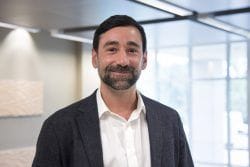
What is your research focus? What initially attracted you to your field?
Our lab aims to unlock the potential of food, fungi, and plant-based natural products to benefit agriculture and animal and human health. Through flavor chemistry, we aim to identify key aroma and taste active molecules in foods and beverages with the vision of developing “Healthy Foods with Great Flavor.” Through natural products chemistry, we aim to identify biologically active molecules with the vision of developing “Novel Natural Products for Health and Agriculture.” The overarching objectives of our integrated program are to guide the development of healthy foods with great flavor, to develop new specialty crops for farmers, and identify novel preventative and treatment options to combat global health afflictions such as diabetes, cancer, and emerging infectious diseases. What initially attracted me to these intriguing fields of research was the realization that nature contains a virtually limitless supply of bioactive molecules that are waiting to be discovered. Many of these molecules have the potential to benefit humans, animals, and the environment.
What do you hope to bring to your journal?
Flavor science and natural products chemistry are two of my passions. I am particularly interested in studies that contribute to the fundamental aspects of these two disciplines, especially those with the potential to be further developed, in an applied fashion, to benefit people, food, and agriculture.
What are the major challenges facing your field today?
Supplying the world with sustainable, affordable, safe, healthy, and delicious food.
What do you think is the most interesting and/or important unsolved problem in your field?
I find it fascinating that, through trial-and-era, nature has generated an enormous suite of time-tested bioactive molecules with the potential to benefit humans, animals, and the environment. This creates a huge opportunity to discover uses for these natural products to benefit society.
Do you have a recent paper in an ACS journal that you’d like to highlight?
This recently published manuscript details the aroma chemistry of a pleasantly unique smelling mushroom endemic to the Southern Appalachians.
Key Odorants from the Fragrant Bolete, Suillus punctipes
J. Agric. Food Chem. 2020, 68, 32, 8621–8628
DOI: 10.1021/acs.jafc.0c03389
Anything else you’d like readers to know about you?
I enjoy spending time with family and friends, exploring nature, reading, and gardening.
***
Geoffrey Coates, Journal of the American Chemical Society

What is your research focus? What initially attracted you to your field?
The research focus of the Coates Group is the development of new catalysts for the synthesis of macromolecules and small molecules. Professor Coates’ research concentrates on developing new methods for reacting commodity feedstocks in unprecedented ways. His current research centers on the development of homogeneous catalysts for olefin polymerization, heterocycle carbonylation, epoxide homo- and copolymerization, the utilization of carbon dioxide in polymer synthesis, and new polymers for energy conversion and storage.
What do you hope to bring to your journal?
I hope to bring additional expertise in catalysis and polymer chemistry to the journal.
What do you think is the most interesting and/or important unsolved problem in your field?
Society depends on polymeric materials now more than at any other time in history, despite increasing concern that their synthesis and disposal are unsustainable. The development of new routes to polymers that have reduced environmental impact is one of the most important unsolved problems in the field of polymer chemistry.
Do you have a recent paper in an ACS journal that you’d like to highlight?
Isotactic Poly(propylene oxide): A Photodegradable Polymer with Strain Hardening Properties
J. Am. Chem. Soc. 2020, 142, 14, 6800–6806
DOI: 10.1021/jacs.0c01768
***
Christophe Coperet, Journal of the American Chemical Society
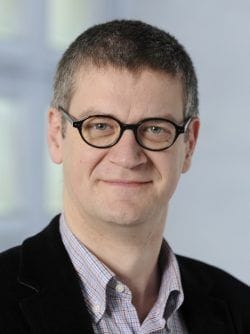
What is your research focus? What initially attracted you to your field?
I study surface chemistry along with catalysis, nuclear magnetic resonance, X-Ray Absorption, metathesis, and CO2 hydrogenation. I study surface chemistry because of its unusual structure and reactivity. It requires me to try to bridge the gap between molecular and solid-state chemistry.
What do you hope to bring to your journal?
A molecular view on heterogeneous catalysis and the ability to look at interfaces with the eye of a molecular chemist.
What are the major challenges facing your field today?
The requirement for a broad range of expertise (from synthetic molecular chemistry to solid-state chemistry, including the use of advanced multiple spectroscopy techniques, as well as computational approaches) to embrace the complexity of surface chemistry. Also, data analysis is becoming complex and demanding due to the ever-increasing size of the data set, along with time- (Operando) and space-resolved spectroscopy.
What do you think is the most interesting and/or important unsolved problem in your field?
Finding a way to capture the dynamics of surface (active) sites under operating conditions, combining imaging and spectroscopy.
Do you have a recent paper in an ACS journal that you’d like to highlight?
Nanoparticle O–H Bond Dissociation Free Energies from Equilibrium Measurements of Cerium Oxide Colloids
J. Am. Chem. Soc. 2021, 143, 7, 2896–2907
DOI: 10.1021/jacs.0c12799
Anything else you’d like readers to know about you?
I am a fan of literature, philosophy, music, and wine.
***
Carlos Nieto de Castro, Journal of Chemical and Engineering Data
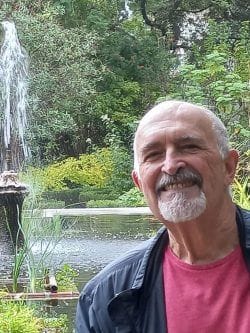
What is your research focus? What initially attracted you to your field?
My scientific activity covers the field of molecular thermophysics and fluid technology, ionic liquids, nanofluids, ionanofluids, and nanosystems, including new heat and storage fluids with industrial impact in the area of energy and the environment, and the use of ionic liquids as solvating and reaction media to synthesize and functionalize nanomaterials, for industrial and domestic applications. Attracted by thermodynamics and transport processes in chemical systems, namely in a liquid state. To solve new problems in chemical engineering and physical chemistry.
What do you hope to bring to your journal?
My experience in science and technology, from doing, directing, and writing. Rigor in data acquisition and presentation for thermophysical properties of fluids (experiment and modeling). Ethics in publications. My strong belief in the capacity of science and technology, namely chemistry and chemical engineering, to transform the world.
What are the major challenges facing your field today?
Nanomaterials characterization, new heat transfer, and storage fluids and materials, use of renewable energies, namely solar, in domestic and industrial applications. The lack of financing in physical chemistry/thermophysical research. The resistance of young people to think scientifically.
What do you think is the most interesting and/or important unsolved problem in your field?
Liquid state molecular theory. Structure of nanofluids and parent dispersions.
Do you have a recent paper in an ACS journal that you’d like to highlight?
It is not very recent but it was a fundamental paper for the use of ionic liquids as base fluids for nanofluids. The term IoNanofluids was created then and sprayed over in the literature:
Thermal Properties of Ionic Liquids and IoNanofluids of Imidazolium and Pyrrolidinium Liquids
J. Chem. Eng. Data 2010, 55, 2, 653–661
DOI: 10.1021/je900648p
Another one fundamental in the area:
Influence of Thermophysical Properties of Ionic Liquids in Chemical Process Design
J. Chem. Eng. Data 2009, 54, 9, 2569–2575
DOI: 10.1021/je900107t
The most recent one:
Thermophysical Properties of 1-Butyl-3-methylimidazolium tris(pentafluoroethyl)trifluorophosphate, [C4mim][(C2F5)3PF3], and of Its IoNanofluid with Multi-Walled Carbon Nanotubes
J. Chem. Eng. Data 2021, 66, 4, 1717–1729
DOI: 10.1021/acs.jced.0c01017
Anything else you’d like readers to know about you?
I am one of the world’s most cited top scientists in chemical engineering/physical chemistry, in the top 2% for 2020 and 2021, according to Stanford University.
***
Nanshu Lu, Nano Letters
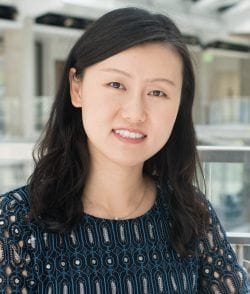
What is your research focus? What initially attracted you to your field?
My research focuses on thin-film mechanics and soft bio-integrated electronics. Representative works of my group include stretchability of metal thin films and serpentine ribbons, nano-bubbles and nano-tents formed by 2D materials, epidermal electronics, graphene e-tattoos (GETs), “cut-solder-paste” rapid prototyping of wireless e-tattoos, bio-electronics interface mechanics, and hybrid piezoresistive and piezocapacitive responses of pressure sensing e-skins. I enjoy both achieving the fundamental understanding of the mechanics of thin-film materials as well as making technical advancements enabled by those fundamental understandings.
What do you hope to bring to your journal?
I hope that my expertise in thin-film mechanics and soft devices can be an unconventional addition to Nano Letters because it is no longer just limited to chemistry or chemical engineering. Instead, we are trying to recognize that mechanics, materials, and electronics all contribute synergistically to future devices with hybrid nano and macro components.
What are the major challenges facing your field today?
A major scientific challenge is the synthesis of intrinsically soft and stretchable high-performance electronic materials such as organic conductors and semiconductors, which can ultimately replace metal and silicon while still being tissue soft. A major technical challenge is the reliable and robust interfacing of the soft, nano components with rigid, macroscopic components like silicon chips or printed circuit boards.
What do you think is the most interesting and/or important unsolved problem in your field?
I envision that in the future, humans will be more like robots (i.e., digital, computational, connected to the internet, etc.) whereas robots will be more like humans (i.e., soft, human-mimetic actuation and sensation, artificial intelligence, etc.). To achieve this vision, we need better brain probes to decipher the human brain and better soft actuators to behave like artificial muscles.
Do you have a recent paper in an ACS journal that you’d like to highlight?
I was one of the iCANx/ACS Nano inaugural rising star lecturers in 2020. Therefore, I just submitted an invited perspective on soft capacitive pressure sensors to ACS Nano. I hope to share it when this perspective is published.
Anything else you’d like readers to know about you?
I endeavor to break the barriers between disciplines and I need everyone’s help with that.
***
Liberato Manna, Nano Letters
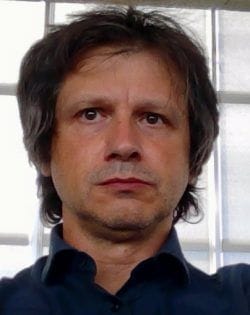
What is your research focus? What initially attracted you to your field?
My main research focus is on colloidal nanocrystals. My group targets their synthesis, surface functionalization, modeling, the study of their physical properties, and their applications, mainly in energy-related fields.
What do you hope to bring to your journal?
I hope to bring my expertise in nanoscale materials science, both from a chemistry and physics perspective, and to cover a wide array of materials and properties.
What are the major challenges facing your field today?
There are several challenges. I would mention perhaps only two. One is getting nanoscale materials that are stable and that have a level of environmental compatibility that makes them suitable for widespread applicability. A second important issue is related to the reproducibility of results from lab to lab, which will require more standardized procedures, sharing of raw data, and certification of performances on a broader scale than has been done so far.
What do you think is the most interesting and/or important unsolved problem in your field?
I am now working mainly in the field of halide perovskites. The most unsolved issue in this field is to find valid alternatives to lead-based compositions. This is still an open quest. Another important challenge in colloidal chemistry, in general, is being able to synthesize materials, in the form of high-quality colloidal nanocrystals, that in the bulk require high temperatures to be prepared with good crystallinity and/or in a desired phase/composition.
Do you have a recent paper in an ACS journal that you’d like to highlight?
Sb-Doped Metal Halide Nanocrystals: A 0D versus 3D Comparison
ACS Energy Lett. 2021, 6, 6, 2283–2292
DOI: 10.1021/acsenergylett.1c00789
This recent work from our group stresses the importance of the extent of connectivity of the coordination polyhedra on one side, and or surface trap states on the other side, on regulating the optical properties of nanoscale metal halide crystals.
Anything else you’d like readers to know about you?
Please don’t focus only on science, but cultivate other interests that enrich your life and make you a more complete person.
***
Elena Besley, Nano Letters
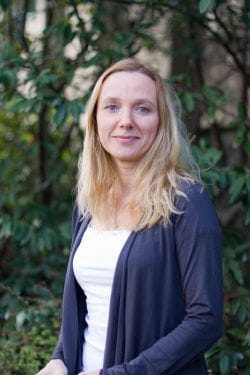
What is your research focus? What initially attracted you to your field?
I am working in the field of theoretical and computational chemistry. I very much like the rigor of theoretical methods, which we use to interpret and predict the outcomes of experimental observations. Mathematics allows us to treat a physical problem with a high level of accuracy and precision, yet often leads us to general conclusions about the underlying mechanisms.
What do you hope to bring to your journal?
Computational science is still at the very beginning of its growth as compared to experimental science, which already enjoyed four centuries of development and advancement. With Nano Letters, I hope to create a strong platform for computational science that can be used to explore nanoscale phenomena not always directly accessible to experiment in key scientific areas such as atmospheric science, materials science, molecular biology, colloidal chemistry, aerodynamics, and elementary particle physics, to name a few. I hope to highlight the highest quality development works by computational chemists, mathematical chemists, and physicists, chemical informaticians who underpin and explain new ground-breaking experimental results.
What are the major challenges facing your field today?
The major challenge that faces us is to develop our abilities to pose and solve problems that combine insights from more than one discipline within the natural sciences with mathematical tools and computational skills. This provides a unique combination of applied and theoretical knowledge.
What do you think is the most interesting and/or important unsolved problem in your field?
We need to continue developing new computational methods that make challenging physical and chemical problems more tractable on modern computing platforms. We also need to change the future of computer simulations. For example, combining machine learning and data analysis with quantum computing is an exciting topic, which can completely change the future of computer simulations and the way we study physical systems at the nanoscale. There are also many unresolved problems in algorithm development, error control, and software productivity.
Do you have a recent paper in an ACS journal that you’d like to highlight?
Triplet Excitation and Electroluminescence from a Supramolecular Monolayer Embedded in a Boron Nitride Tunnel Barrier
Nano Lett. 2020, 20, 1, 278–283
DOI: 10.1021/acs.nanolett.9b03787
In this paper, we show that ordered monolayers of organic molecules stabilized by hydrogen bonding on the surface of exfoliated few-layer hexagonal boron nitride (hBN) flakes may be incorporated into van der Waals heterostructures with integral few-layer graphene contacts forming a molecular/two-dimensional hybrid tunneling diode. Electrons can tunnel through the hBN/molecular barrier under an applied voltage, and we show that tunneling electrons excite embedded molecules into singlet states in a two-step process via an intermediate triplet state through inelastic scattering and also observe direct emission from the triplet state. These heterostructures provide a solid-state device in which spin-triplet states, which cannot be generated by optical transitions, can be controllably excited and provide a new route to investigate the physics, chemistry, and quantum spin-based applications of triplet generation, emission, and molecular photon upconversion.
***
